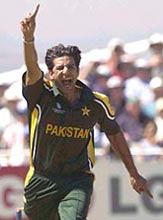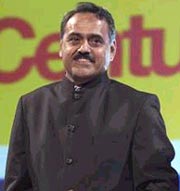Home > Cricket > World Cup 2003 > Columns > Sunaad Raghuram
Against all odds
February 23, 2003
The debilitating effects of disease and deformity, the physical repercussions of an accident, can leave even the most stout-hearted of us in a heap of self-pity, where the forces of the mind's negativity, swamp our very being.
But sometimes, even amidst the sepulchral setting of a hospital ward; the grave prognostications of medical wisdom; the hopelessness, the inevitability, the no-other-way-out acceptance of the largely undecipherable dictates of destiny; bloom the most cherished human qualities of them all; those most refreshing, gloom-dispelling, joy-inducing, life-enhancing and spirit-fuelling blooms. Of human perseverance, of dogged determination and dedication, of indomitable will, an inscrutability of temperament and inextinguishability of soul which gives the power to climb that most arduous of mountains -- 'Mt. Misery' -- which, given the smallest of chances, will lord over human fate.
 There are men in this world in whom you find a truly stupefying range of qualities which make them special; lending to their personalities an almost super-human aura; a halo of impregnability against the imponderable roll of the cosmic dice; to whom disease and deformity are just not limiting factors in their march towards excellence and achievement. Men like Wasim Akram, Jonty Rhodes, Bhagwat Chandrashekar and Mansur Ali Khan Pataudi.
There are men in this world in whom you find a truly stupefying range of qualities which make them special; lending to their personalities an almost super-human aura; a halo of impregnability against the imponderable roll of the cosmic dice; to whom disease and deformity are just not limiting factors in their march towards excellence and achievement. Men like Wasim Akram, Jonty Rhodes, Bhagwat Chandrashekar and Mansur Ali Khan Pataudi.
Without a shade of doubt, the greatest ever left arm fast bowler in the history of cricket, Wasim Akram, has walked the cricket turfs of the world with the authority, power, panache and confidence of a true performer. A performer, who with his great skills, has doomed batsmen of all temperaments and talents and for eighteen long years at the international level; his tally a mind-boggling 400-plus wickets in Tests and just one short of a massive, monumental figure of 500 wickets in one-day cricket.
I wonder how many more wickets this man would have bagged; how much higher he would have climbed the ladder of achievement and how much greater he would have been known to be; if only, quite tragically, he had not had a medical condition known as diabetes to contend with, so early in life. A medical condition, which in situations where the dietary regulations are given a go by, can sap energy levels in the human body to such extents that the sufferer could even collapse.
 But when Akram runs in to bowl his well directed away swingers with a quick arm action which enables him to generate tremendous pace, the batsman wouldn't be allowed to think, even for an infinitesimal moment, that here is a man who is not, strictly from a medical view point, in the best of health, and hence could be trifled with. Well, Andrew Flintoff, the English all-rounder went on record, before his team's game against the Pakistanis at the Newlands on Saturday, tongue-in-cheek, I'm sure, that he wouldn't mind being Akram's 500th victim when he's on 135. Some sense of humour this from the Englishman. But have the other 499 men who have been snared by the pernicious Akram had any opportunity to even smile faintly, let alone come up with smart one-liners? Not really when they've had a die-hard of a man coming at them with the menace of an army tank and the velocity of a well guided missile put together!
But when Akram runs in to bowl his well directed away swingers with a quick arm action which enables him to generate tremendous pace, the batsman wouldn't be allowed to think, even for an infinitesimal moment, that here is a man who is not, strictly from a medical view point, in the best of health, and hence could be trifled with. Well, Andrew Flintoff, the English all-rounder went on record, before his team's game against the Pakistanis at the Newlands on Saturday, tongue-in-cheek, I'm sure, that he wouldn't mind being Akram's 500th victim when he's on 135. Some sense of humour this from the Englishman. But have the other 499 men who have been snared by the pernicious Akram had any opportunity to even smile faintly, let alone come up with smart one-liners? Not really when they've had a die-hard of a man coming at them with the menace of an army tank and the velocity of a well guided missile put together!
Cut to a fieldsman. A man like none other. A man who redefined the art of stopping, catching and throwing a cricket ball. A man who made you wonder if he had a pair of well shaped wings that helped him fly with the same magnificence of an eagle. A man who gave you the impression on a cricket field, that he was born, not to walk the earth like a mere mortal, but destined to soar into the blue yonder with the grace, agility and pomp of a jet aeroplane taking off. Acrobatic in the most mundane of moments and brilliantly so in crunch situations, Jonathan Neil Rhodes, left the world of cricket gawking in awe, rubbing its eyes in sheer bewilderment and applauding in a state of mesmerized frenzy.
The sight of the South African, prowling in the region of cover point and moving towards the wicket with the stealth of a Cheetah on the hunt, as the bowler began his run-up, and then taking off, in a blinding flash, hands outstretched and cupped at the top, in a sort of curving trajectory which defied all known forces of gravitation and coming down with either a scintillating catch or even a plain save, will undoubtedly remain one of the most enduring in the game. And which cricket buff can ever forget Jonty's run out of Inzaman-ul-Haq on the 8 March, 1992, at the Gabba during the World Cup in Australia. Body completely stretched and almost horizontal to the ground, with ball in hand and one eye on the desperately running batsman, Jonty threw the wicket down, to effect one of the most famous and thrilling run-outs in cricket history. He halted the Pakistanis march towards victory and galvanized a million youngsters to pick up a cricket ball with a never-before-seen gusto. It was Rhodes's public admission that he was epileptic that gave the world the only intimation of him being mortal!
 And then you had Bhagwat Chandrashekar. A bowler, who was a mystery, strapped to a puzzle, covered in an enigma, wrapped in a riddle and packed in a cryptogram! The only genuine, attacking and match winning Indian bowler of his time, Chandra bamboozled, befuddled, disorientated and bewildered batsmen with his fastish leg breaks and googlies that came at almost the speed of a medium pacer. The Englishmen got to see his magic, when at the Oval in 1971, Chandrashekar made the ball to not just 'talk' but 'sing', as it went past the outstretched bat to either crash into the stumps, or the pads or take an edge not once, but six times! Chandrashekar had 6 for 38, in one of the most unplayable spells in the annals of cricket. He did this and more (like when he had a certain Vivian Issac Alexander Richards completely clueless in the Bangalore Test of 1974-75) for all the years that he played for India to close shop with a bag of 242 Test match wickets. And this, Chandrashekar did with a bowling arm that had been rendered extremely fragile by an attack of polio as a child!
And then you had Bhagwat Chandrashekar. A bowler, who was a mystery, strapped to a puzzle, covered in an enigma, wrapped in a riddle and packed in a cryptogram! The only genuine, attacking and match winning Indian bowler of his time, Chandra bamboozled, befuddled, disorientated and bewildered batsmen with his fastish leg breaks and googlies that came at almost the speed of a medium pacer. The Englishmen got to see his magic, when at the Oval in 1971, Chandrashekar made the ball to not just 'talk' but 'sing', as it went past the outstretched bat to either crash into the stumps, or the pads or take an edge not once, but six times! Chandrashekar had 6 for 38, in one of the most unplayable spells in the annals of cricket. He did this and more (like when he had a certain Vivian Issac Alexander Richards completely clueless in the Bangalore Test of 1974-75) for all the years that he played for India to close shop with a bag of 242 Test match wickets. And this, Chandrashekar did with a bowling arm that had been rendered extremely fragile by an attack of polio as a child!
Talking of bowling, let me take you to the time when men who went by the names of Wesley Hall, Garfield Sobers, Andy Roberts, Vanburn Holder, Graham McKenzie, Richard Hadlee, Lance Gibbs, Ashley Mallet and Dereck Underwood played the game. All these men bowled a cricket ball with the pace, guile, craft and tact that had not been seen in most others ever. And these are the men that Mansur Ali Khan faced and battled. With the same courage and spirit that his ancestors had perhaps displayed to protect their fiefdom of Pataudi against aggressors in the past. Six hundreds and sixteen fifties in Test cricket, with 203 not out as the highest score, to make up the statistics; his was a story of amazing grit, sharpness of mind, courage of conviction and an attitude that screamed 'never ever give up'.
The Nawab of Pataudi, as he was popularly known, was a man who believed in leadership through example. What better example than the second Test against Australia in 1967-68 at Melbourne when a rampaging McKenzie took 7 for 66 in the first innings and 3 for 85 in the second with only Mansur Ali Khan standing amidst the ruins with scores of 75 and 85. A born leader, Pataudi instilled in the Indian team, a sense of pride and honour in playing for the country. As was shown in the intense and closely fought series against the West Indies at home in the season of 1974-75.
Here was a man who fought not the battles of Pataudi, but the dramatic fights of Indian cricket on the fields of the world. And here was a man, who did all that he did, with just one normal eye! The other one having been so heartrendingly lost in an automobile accident in England in 1961! The next time you try catching a ball gently tossed in your direction in the safety and comfort of your drawing room, with your hand cupping one eye, think of the great Pataudi. Because he mostly never lost sight of it, like you perhaps did. And the ball, in his case, invariably came at a pace, which most of us cannot even comprehend!
Let's give Wasim Akram an obeisance. And also Jonty, Chandra and the indefatigable Mansur Ali Khan Pataudi. For in their story, lies the secret of inspiration that millions of youngsters, the world over, would be searching for.
Sunaad Raghuram is the author of 'Veerappan The Untold Story', Viking, 2001
More Columns